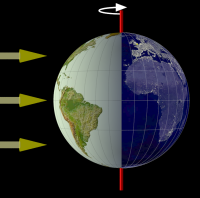SR #4: Two Rules
 Half-Day for All!
Half-Day for All!It's Friday, and I'm sure you're thinking about the weekend, so today will be just a review and some more details about the speed of light.
And speaking of light, today is the Vernal Equinox. For the next six months (for those of us in the northern hemisphere), our days will be longer than our nights. No doubt the combination of spring, the Equinox, and the weekend, have you wondering what you're doing at your computer reading about Special Relativity.
So I'll try to be very brief…
I said last time that light always goes at the same speed from all perspectives. We give that speed a name: c. What I didn't mention is what that speed is:
- It's 186,282.860 (call it 186,000) miles per second
- Or 299,792.458 (call it 300,000) kilometers per second
That's a lot of distance in a single second; it's hard to imagine. If we think about it in terms of vehicle speeds (planes, trains, and automobiles), we get more of a flavor of just how fast light is:
- It's 671 million miles per hour!
- Or 1,079 million kilometers per hour!
 Grace Hopper, the First Lady of modern computing, used to hand out foot long sections of phone wire as an illustration.
Grace Hopper, the First Lady of modern computing, used to hand out foot long sections of phone wire as an illustration.It's still pretty hard to imagine! Another way to look at it is that light travels about one foot in one nanosecond (which is one-billionth of a second).
For metric readers: light travels about one meter in three nanoseconds.
That's an inconceivably tiny time slice to consider, so how about this: light travels 1000 feet in one microsecond (one-millionth of a second).
(As reference point, recall that a football field is only 300 feet long, so we're talking three football fields plus one-third of another.)
Still kinda hard to wrap our heads around!
One more way to look at it is that it takes just over 5.3 microseconds for light to go one mile. And it takes just over 3.3 microseconds to go one kilometer.
I'm not really sure that helped; who does microseconds? Let's try some serious distances:

The Moon is roughly one-quarter of a million miles away (on average about 238,855 miles or 384,399 km, although this varies a bit).
It takes light about 1.3 seconds to make that trip.
So Moonlight is well over a second old by the time you see it! Think about that the next time you gaze at the Moon — you're actually seeing it as it was 1.3 seconds ago.

The Sun, which is roughly 93 million miles away (or about 150 million km), is 8.3 minutes away at light speed.
If the Sun went out in an instant (a physical impossibility, so don't worry about it), we wouldn't know it for over eight minutes and twenty seconds! (And hopefully it goes without saying: Don't ever look directly into the Sun!)
The point is, light is fast. Really fast. In fact, it's the fastest thing in our universe. It's also about the only thing that is that fast. Nothing made of (what most people think of as) matter can be made to go that fast. Certainly no physical object can.
 Very fast; very special!
Very fast; very special!I'll touch on exactly why that is later in the series. For now take it as read that light is special, and light is very fast.
(And when you think about how important light is to us, you realize just how special it is.)
Incidentally: A light year is not a duration of time; it's an amount of distance. Time-wise, a light year is… just a year. (Ten light years takes ten years.)
A light year is the distance light travels in one year. That is:
- 1 LY = 5,878,639,982,736 miles
- 1 LY = 9,460,730,472,580 kilometers
If you got lost in all those digits, it's 5.88 million million miles — what many countries call a trillion. (Or 9.46 million million km.) So a light year is a very long distance. In comparison, distant Pluto is about 5.4 light hours away.
One last point about light: When we talk about light speed, we're talking about its speed in a vacuum (for instance, in space). Light goes a little bit slower in air and slower still through glass or water.

In fact, this difference of speed between air and glass is what makes lenses work.
The difference between air and water is also why a straw in a glass of water appears to take a sharp bend at the water's surface.
The technical term is refraction (and I won't be covering that at all).
Let's Review
Here's what I hope you take away from this week's posts:
- SR #0: Standing still and moving at a constant straight-line speed are indistinguishable. There is no possible experiment that can tell the difference.
- We refer to this situation as an inertial frame of reference.
- Given two such frames, each observer can claim they are motionless while the other is moving (or vice versa). All such claims are valid!
- SR #1: Acceleration (speeding up or slowing down or changing direction) changes the situation because you can feel the force. Now you can tell you're moving.
- SR #2: An object moving within your frame of reference moves at a speed you can measure, but observers in a different frame of reference will get different measurements of that speed.
- This is because of the relative motion between the two frames.
- SR #3: The relative motion of a frame adds to the motion of an object moving within the frame. The result is the object seeming faster or slower to outside observers, depending on its direction of motion.
- This business of relative velocity was understood by the ancients. Galileo explored it thoroughly, so we call it Galilean Relativity.
- This does not (repeat: not) apply to light, which always moves at the same speed to all observers. This exception changes everything.
- And SR #4: Light is fast. Really fast. It's the fastest thing in the universe. And it's a game-changer for Special Relativity.
- We call this speed c, and it's easily remembered as being almost exactly 300,000 km/sec.
If any of this isn't absolutely clear to you, now would be a good time to ask questions. You can ask them here or go back to the article that wasn't clear. I really do want to know if anything didn't click for you!
SR: Two Rules
I'm taking (and giving you) the weekend off. When we continue (likely on Monday), I'll start explaining time-space diagrams. These are important for understanding the explanations that follow, so I may spend the entire week on them.
In the meantime, I want to set the basic context for what extends Special Relativity from Galilean Relativity (which we have explored in detail this week).
The Theory of Special Relativity depends on two rules:
- Galilean Relativity is true, in particular with regard to the equivalence of frames (no experiment can distinguish constant motion from standing still). And physical objects have relative motion to different observers.
- The speed of light is constant to all observers regardless of their frame of reference.
As we'll see, taking that second rule as true has some downright bizarre consequences.
Have a great weekend! Celebrate the Equinox and enjoy the light!